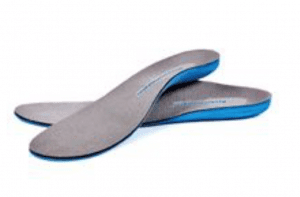Orthotics have been the big debate for the last few years on whether they are good or not good for you. This debate has been going back and forth for years with no real right or wrong answer.
The truth of the whole debate is; it all depends.
As human beings, we are born and built to be barefoot. Somehow we got on a train to start wearing shoes and have an outside source do the job of our foot for us so that we don’t have to. This became a problem because since we don’t use our foot muscles as much while wearing shoes, they begin to become very weak and atrophy which leads to many problems. When we add in another outside source, such as an orthotic, we are adding more to something that will take the job of the foot.
The most common times you will hear someone saying that they need orthotics is because they have either a high arch, or have a flat foot. If you have a high arch to begin with, why would we want to add a support system that will cause even more degeneration and weakening of the muscles and ligaments that make up your arch. These are already stretched out more than normal and a orthotic will just assist in the weakening and laxity of the musculature. If someone has a flat foot those arch muscles are not strong at all and the use of an orthotic would continue to atrophy those muscles even more because they are not being used the way that they should.
The problems start to come only when someone is having pain due to a high or very low arch. Orthotics are not supposed to be used as a permanent solution. Orthotics are a great short term solution if someone is having pain to relieve some of that pain and then they would need to start to strengthen the musculature required to support that arch so they don’t need another outside source to do its job.
Most often people with a ridgid foot, also known as a high arch even when weight bearing, wear orthotics. This is because when they walk, they are mostly supinated (when the foot rolls out more), and also have less range of motion (mainly dorsiflexion). When someone with a ridgid foot walks, they do often do not have the heel to toe gait pattern and walk with more of a flat foot which causes the rest of the body to take more of the shock absorption. With the orthotic in place, this allows support to your arch and support to the lateral aspect of the ankle which will help reduce the risk of ankle injuries or sprains.
Orthotics are a great short term solution for fallen or high arches, but is not a great long term solution. Like shoes, orthotics continue to take the job of our feet and atrophy the muscles even more. If you have or plan on getting orthotics, make an effort to strengthen the musculature that is weak in conjunction to the orthotics so you can eventually get rid of them. If you or someone you know has this problem, physical therapy is a great solution to help strengthen these areas that have been atrophied. In the meantime before you can get a scheduled appointment with a professional, here are some exercises to start with:
- Arch ups: This is just like what it sounds like; standing with your feet hip width apart, scrunch your toes and try making an arch with your foot. Hold this position for 10 seconds and repeat 10 times.
- Toe curls: Start barefoot standing on a towel, scrunch your toes and try to pick the towel up with your toes. Hold for 10 seconds and repeat 10 times.
- Standing heel raises: Start standing with feet on the ground, raise your heels off of the floor so you are just on the ball of your foot. Hold for 5 seconds and slowly lower yourself back to the floor. Repeat 20 times.
Although we want you to start strengthening your feet so you can get rid of your orthotics, this does not mean that you should stop wearing them cold turkey. Talking to a medical professional is the first step in order to determine if this is feasible first. Then you can start to slowly wean yourself off of the orthotics while doing the proper foot strengthening exercises to make up for the extra support you were having with the orthotics. This process will not be done overnight and will take time to regain your strength.
For those of you who want to learn how to prevent any injuries and avoid any pain go to our website, HERE for a free course on the foot and ankle and learn some exercises you can do right now to help strengthen and get ready for flip flop season.
If you are ready to get started right away, then do not hesitate to give a call at 610-841-3555 and get started on the path to healing right away.
Thanks all for now! Feel free to post any questions in the comments section below and if you sign up for a course you will be able to get to stay on top of all things Robbins Rehab!


